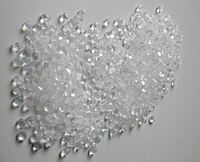
Photo from wikipedia
Lowering processing temperature of poly(ethylene terephthalate) waste (rPET) and ultra-high molecular weight polyethylene (UHMWPE) by blending to avoid decomposition of rice husk fiber (RHF) during the manufacturing of wood plastic… Click to show full abstract
Lowering processing temperature of poly(ethylene terephthalate) waste (rPET) and ultra-high molecular weight polyethylene (UHMWPE) by blending to avoid decomposition of rice husk fiber (RHF) during the manufacturing of wood plastic composite (WPC) was one of the main goals of the research study. (rPET/LDPE)-g-MA and (HDPE/LDPE/UHMWPE)-g-MA blends were prepared with good flowability at 240°C. The MA grafted chain in the blends were verified by FTIR. Good miscibility and compatibility of the blends were revealed by SEM. The effect of blends ratios employed as blended matrices on performance properties of the manufactured WPC were explored. MFI and HDT were increased with decreasing (rPET/LDPE)-g-MA ratio. The reversed domain phase between rPET and blended PE mixture was pronounced at 50:50 ratio. Mechanical performances were generally reduced upon decreasing the (rPET/LDPE)-g-MA ratios. The reduction of high strength rPET fraction in the blended matrices was taken as the main cause. Exceeding the reversed phase ratio, the declining of the toughness was retarded due to rising on the interfacial strength and UHMWPE toughener fraction. The effect of DCP/VTMS crosslinker on the properties of the macro crosslinked WPC (XWPC) was investigated. The elastomeric bridges on the sauna cured WPC samples were revealed by SEM. High crosslink density upon increasing the crosslinker fraction had an obvious effect on MFI, HDT, toughness and ductility of the macro crosslinked XWPC. However, the flexible characteristic of the elastomeric amorphous PE chains in the blended matrices at high DCP/VTMS usage was manifested as brittleness retardant for the macro crosslinked XWPC.
Journal Title: Journal of Thermoplastic Composite Materials
Year Published: 2023
Link to full text (if available)
Share on Social Media: Sign Up to like & get
recommendations!